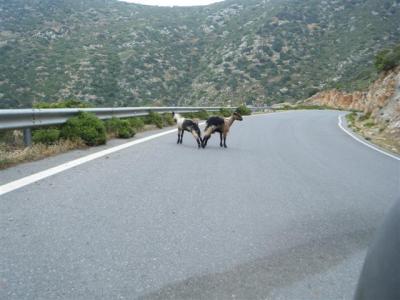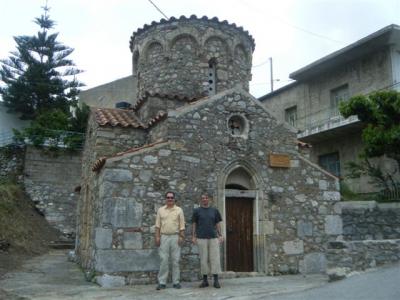Wednesday, May 20 This afternoon Andronikos, Eric and Christi set out to go to an archeological site called Axon, located in the mountains. We followed the same road that we took the day we took the day we went to the monastery and cave last summer. Last year it had been and the hills were dry. Right now the hills are verdant and green, with the flowers in full bloom. It is absolutely gorgeous. Just like last year, we saw lots of goats running around on the hills and several hanging out on the road.

We passed the monastery, but before we got to the cave we turned off onto a different road. We passed through several more small villages. One of them was the village where we had gone to the wedding with 3,000 guests a few years ago and has a reputation for being one of the most traditional villages left today. In another village, we spotted a 16th century church that looks like it is still in use. We tried to go in, but it was closed.

The towns are nothing more than a small cluster of closely set buildings in the middle of raw land as far as the eye can see. We think it is funny that with so much empty space around them, they choose to live on top of their neighbors, both figuratively and literally speaking. You rarely see houses outside of the towns.
Unfortunately, archeological sites on Crete all close fairly early in the day, and we had seriously underestimated how long the drive would take. We forgot how windy and slow go the mountain roads in Crete can be. There was no way we could make it to the ruins before they closed. So, instead of Axon, we went to another village near it called Zoniana. Zoniana is on the tourist map for some caves that are supposed to be cool, but its real claim to fame in recent years is that it is a mafia village.
Apparently, two years ago a man from Zoniana was arrested. He drove a Porsche and allegedly had millions in the bank, which is suspicious for a guy from a farming town. An investigation started. It seemed that the village was growing cannabis in the olive groves, where the pot was blocked from view by the olive trees. They seemed to have a hashish plantation hidden in the hills outside the village. They seemed to be dealing drugs. They seemed to be involved in a series of armed robberies and protection rackets. So, 40 officers went into the town to do a raid. Before they could even enter the first house, 20 gunmen attacked the police with assault rifles. The police retreated. 75 special force officers were flown in from Athens a couple days later and, along with 55 local police, there was a 6 day stand off. Andronikos said that most everyone in the village was shooting at the police, including women and children. We can totally imagine the little 5 foot, 90 pound great-grandmas wielding automatic weapons. The older generation of Greeks are tough as nails. The police eventually were able to get the situation under control, conduct searches, and make arrests. Apparently, in addition to everything else they were up to, they were also gun runners and had copious amounts of explosives. The trials for that fiasco are going on right now. 42 are on trial.
Anyway, we decided to go to Zoniana instead because 1. we thought maybe the caves would be open later than the ruins were and 2. Andronikos was curious to see the infamous village. For the most part, Zoniana looks like all the other towns in the general area, though bullet holes are definitely noticeable in many buildings. The streets were mostly empty and all seemed to be quiet. We didn’t see any police around, nor any armed men hiding behind door posts lying in wait for the police (and we had our eyes peeled). How disappointing. We were hoping for some action.
We were looking for the caves when we came across the Potamianos Museum. It was open, so we went in. The museum is small and visually cute, with lots of photos and art on the walls and many displays featuring cartoonish looking wax figures. However, some of the content was actually a bit disturbing. While some of the museum is devoted to the history of Crete, most of it is about the horrors of the Turkish occupation
So, starting with the non-disturbing information. Many Cretan leaders from the Byzantine Era through today were highlighted, including war heroes, writers, poets, painters (including the famous Il Greco), and politicians (including a Byzantine Emperor and the founder of the Greek liberal party). There was an interesting exhibit of how Greece’s borders have changed over the years. There were some pretty photos, paintings and drawings of Crete throughout history. And they talked a little about how they managed to keep the Greek culture, language and religion alive during the Turkish occupation.
We want to preface the disturbing stuff with some commentary. As you know, the histories of Greece and Turkey have been strongly intertwined since ancient times. When we were doing research for the History of Greece and the History of Turkey posts, we were struck by the total disparity between the two different interpretations of events. In fact, the slant in perspective is so significant that you would swear that the two sides could not possibly be referring to the same incidents. The one thing that most strongly resonated with us in writing those posts is that anger begets anger, and violence begets violence. When one side commits an atrocity, whether justified or not, the other side feels obligated to get even. The side receiving the counter attack feels equally horrified by violence and feels the need to get even, and so the cycle continues. One thing that is clear is that war is equally painful for all sides.
So, that said, this museum showed only the Greek perspective. It was clearly designed by someone who hates the Turks passionately and wants to preserve the hate for future generations. For example, the majority of photos on display showed the damage done by Turkish soldiers around the island, which is factual. But someone had drawn images of blood dripping on the matting, which clearly was intended to provoke additional anger. Another example is one of the larger wax figure scenes that was absolutely gruesome. It showed the various methods the Turks used to torture and kill Greek rebels, so wax figures were hung, impaled, etc. We feel that a verbal description of the events would be enough and the graphic depiction was geared at inciting anger. And there were several more exhibits and displays geared at eliciting emotion. We agree it is important to preserve factual history, but not hate. We feel strongly that this generation of Turks should not be demonized for something their great grandparents and great great grandparents did.
After the museum, we decided to head back to Bali. We chose a different road that looked like it would be shorter. Eventually the scenery started to look familiar. We realized we were in Aghia, the town where Koralia’s family has a business. We found the shop with little difficulty and went inside. Koralia’s uncle, grandmother and great aunt were there minding the store. They were definitely surprised to see us, but seemed to be happy we came by.
We had planned a quick stop to say hi and bye, but they insisted on feeding us. Even though we kept saying we didn’t want any food, they brought out a ton. It was like the scene in “My Big Fat Greek Wedding” where the mom asked the fiancé if he wanted a sandwich. He replied no and she handed him one anyway, fully expecting him to eat it. Koralia’s grandma actually whipped up a batch of her delicious goat milk ice cream right then. While waiting for the ice cream, they served yummy chocolate pastries, cookies, those awesome candy figs, and candied oranges. We have tried the oranges before, but we think we forgot to mention them. The entire orange, peel and all, is candied and eaten. They are absolutely phenomenal. I can see why Costas adores Koralia’s family so much. They are all incredibly kind, generous, welcoming and hospitable people. We stayed for quite a while before we realized we needed to get going for dinner with the family back in Bali.
Tomorrow we are heading back to the States, and we would be leaving for the airport before everyone got up, so we said our goodbyes tonight. Eric still wasn’t feeling good, so he went to bed fairly early, but Christi stayed up until the wee hours of the morning, trying to make the most of the time left.
